

The Best Resources For Helping Teachers Use Bloom’s Taxonomy In The Classroom. Bloom’s & SOLO ‘are not Just Colorful Posters we Hang on the Wall’ is my two-part series at Education Week Teacher.

Bloom’s Taxonomy is talked about a lot in educational circles. However, if you believe a recent survey of visits to 23,000 U.S. classrooms, the higher-order thinking skills it’s ideally designed to promote doesn’t get much use. And I can understand why. It’s easy to get caught-up in the day-to-day work involved in teaching a class or multiple classes, and it’s easy to fall into the trap of doing the “usual stuff” and not “think out of the box.” I thought it might be useful to share in a “The Best…” list the resources that help me try to use Bloom’s Taxonomy in my classroom. Shifting From Pedagogy To Heutagogy In Education. The Definition Of Heutagogy & Self-Determined Learning by Stewart Hase and Chris Kenyon Ed note: This is part 1 in a series on self-determined learning from Stewart Hase and Chris Kenyon.
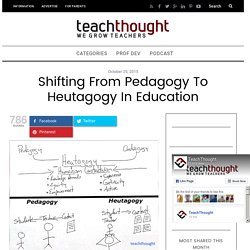
Stewart’s site, Heutagogy Community of Practice, is a useful resource for reading on Self-Determined Learning. Ed note 2: Hase and Kenyon make distinctions between self-determined and self-directed learning that may be in conflict with our use of the terms (see, for example, our self-directed learning model). 14 Brilliant Bloom's Taxonomy Posters For Teachers. 14 Brilliant Bloom’s Taxonomy Posters For Teachers by TeachThought Staff Bloom’s Taxonomy is a useful tool for assessment design, but using it only for that function is like using a race car to go to the grocery–a huge waste of potential.
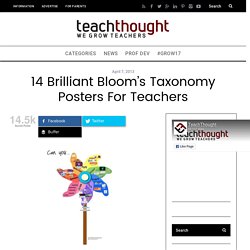
Real Learning is a Creative Process. Those who have studied successful skill mastery describe a common process that is followed, one that requires practice, effort, patience, experimentation and deep concentration.

This is as true for basketball, chemistry and guitar playing as it is for cooking, painting, karate, engineering, parenting and brain surgery. Take the example of language learning. All children are born with the natural ability to learn new languages, they have brains that we might compare to language learning “hardware” in a computer. Over time they master the language of those who surround them, what we might compare to software. But this is where the similarity between computers and humans ends. With a computer you simply transfer the data from one location to another. This is why force-feeding decontextualized “knowledge” and then measuring retention with standardized tests is a dead end approach to education.
Children understand this, intuitively. The 5 Minds of Learners. Chia Suan Chong: A trip down the memory lane of methodology. Chia Suan Chong: A trip down the memory lane of methodology Submitted by Paul Braddock on 1 September, 2012 - 13:00 Date : 29th November 2012 Time : 8pm UK time ( check what time this is in your country ) Watch a recording of the webinar : click on the link below to watch a recording of Chia's webinar Theme : As we walk down the memory lane of English language teaching, we can see a correlation between the trends in the most popular language acquisition theories of its time, and the application of such assumptions into the language classroom.

Since the late 1960's, we've seen Hymes refute the focus on grammatical competence, highlighting instead the importance of communicative competence. Language Teaching Methodology. This is language teaching methodology as modeled by Richards and Rogers (2001).
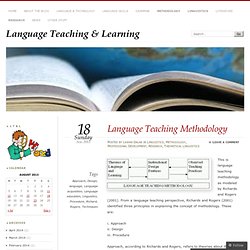
From a language teaching perspective, Richards and Rogers (2001) identified three principles in explaining the concept of methodology. These are: i. Approach ii. Design iii. ESL Learning Styles: 9 Ways to Teach Tactile-Kinesthetic Learners. ESL Learning Styles: 9 Ways to Teach Visual Learners. See it, Hear it, Do it: ESL Activities to Teach to the Seven Different Learning Styles. What Are Language Learning Styles and How Can You Make Sure Your Students Have Them? Bloomin' Apps.
This page gathers all of the Bloomin' Apps projects in one place.Each image has clickable hotspots and includes suggestions for iPad, Android, Google and online tools and applications to support each of the levels of Bloom's Revised Taxonomy.I have created a page to allow you to share your favorite online tool, iOS, or Android app with others.
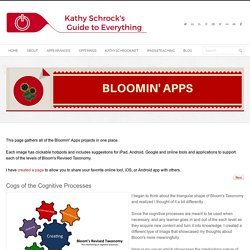
Cogs of the Cognitive Processes I began to think about the triangular shape of Bloom's Taxonomy and realized I thought of it a bit differently.Since the cognitive processes are meant to be used when necessary, and any learner goes in and out of the each level as they acquire new content and turn it into knowledge, I created a different type of image that showcased my thoughts about Bloom's more meaningfully.Here is my visual which showcases the interlocking nature of the cognitive processes or, simply, the "Cogs of the Cognitive Processes".
IPAD APPS TO SUPPORT BLOOM'S REVISED TAXONOMYassembled by Kathy Schrock Bloom's and SAMR: My thoughts. What is UbD™? Understanding by Design® (UbD™) is a framework for improving student achievement.

Emphasizing the teacher's critical role as a designer of student learning, UbD™ works within the standards-driven curriculum to help teachers clarify learning goals, devise revealing assessments of student understanding, and craft effective and engaging learning activities. Developed by nationally recognized educators Grant Wiggins and Jay McTighe, and published by the Association for Supervision and Curriculum Development (ASCD), Understanding by Design® is based on the following key ideas: A primary goal of education should be the development and deepening of student understanding.
Students reveal their understanding most effectively when they are provided with complex, authentic opportunities to explain, interpret, apply, shift perspective, empathize, and self-assess. Understanding by Design. Understanding by Design, or UbD, is a tool utilized for educational planning focused on "teaching for understanding" advocated by Jay McTighe and Grant Wiggins in their Understanding by Design (1998), published by the Association for Supervision and Curriculum Development.[1][2] The emphasis of UbD is on "backward design", the practice of looking at the outcomes in order to design curriculum units, performance assessments, and classroom instruction.[3] "Understanding by Design" and "UbD" are registered trademarks of the Association for Supervision and Curriculum Development ("ASCD").
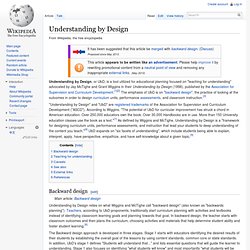
According to Wiggins, "The potential of UbD for curricular improvement has struck a chord in American education. Over 250,000 educators own the book. Over 30,000 Handbooks are in use. More than 150 University education classes use the book as a text Backward design[edit] NICK'S SITE. Costco Connection - August 2012 - Page 32-33. What is learning? Theories of Learning. Change Magazine - September-October 2010. By Cedar Riener and Daniel Willingham There is no credible evidence that learning styles exist.

While we will elaborate on this assertion, it is important to counteract the real harm that may be done by equivocating on the matter. In what follows, we will begin by defining “learning styles”; then we will address the claims made by those who believe that they exist, in the process acknowledging what we consider the valid claims of learning-styles theorists. But in separating the wheat from the pseudoscientific chaff in learning-styles theory, we will make clear that the wheat is contained in other educational approaches as well. Recycling Kolb.